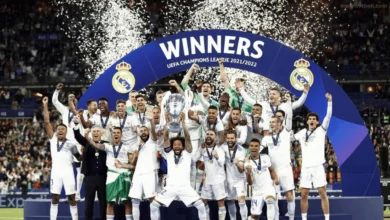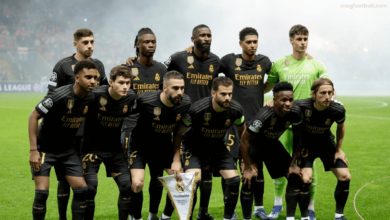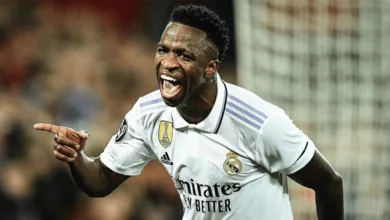How Real Madrid Built a Legacy: The Club’s Greatest Moments

Real Madrid is more than just a football club—it’s a legacy of excellence, a symbol of dominance, and a name that echoes through the history of the sport. Since its inception in 1902, Real Madrid has been at the forefront of world football, consistently achieving greatness and setting benchmarks for other clubs to follow. With a record 14 UEFA Champions League titles and 35 La Liga trophies, Real Madrid’s legacy is unmatched. But how did the club reach these heights? What were the key moments that shaped its history? This article delves into the greatest moments that built Real Madrid’s legacy, exploring the milestones that define the club’s dominance in football history.
Table of Contents
The Foundation of Real Madrid: A Historic Beginning
Real Madrid was founded on March 6, 1902, by a group of football enthusiasts in Madrid. The club’s original name was Madrid Football Club, but in 1920, King Alfonso XIII granted the club the title “Real,” meaning “royal,” thus becoming Real Madrid. The foundation of the club laid the groundwork for a rich footballing culture that would grow to define Spanish and world football. Early victories in regional tournaments helped establish the club’s reputation, but it wasn’t until the mid-20th century that Real Madrid began to truly dominate the global stage.
Santiago Bernabéu: The Architect of Real Madrid’s Success
One cannot discuss Real Madrid’s legacy without mentioning Santiago Bernabéu, the man who transformed the club into a global powerhouse. Bernabéu, a former player, became the club’s president in 1943 and held the position for 35 years, until 1978. Under his leadership, Real Madrid grew from a local team into a global brand.
Bernabéu was instrumental in constructing the Estadio Santiago Bernabéu, one of the most iconic stadiums in the world. He also played a key role in forming the European Cup, now known as the UEFA Champions League. Real Madrid won the first five editions of the European Cup from 1956 to 1960, an unprecedented achievement that set the tone for the club’s dominance in European football.
The 1950s: The Beginning of European Dominance
The 1950s were a golden era for Real Madrid. Led by stars such as Alfredo Di Stéfano, Ferenc Puskás, and Francisco Gento, the club became synonymous with success. The team’s European dominance began in 1956 when they won the inaugural European Cup, defeating Reims 4-3 in the final. Real Madrid would go on to win the next four European Cups, cementing their place as the best team in the world.
During this period, Real Madrid also dominated Spanish football, winning numerous La Liga titles and establishing themselves as the team to beat. The 7-3 victory over Eintracht Frankfurt in the 1960 European Cup final is often regarded as one of the greatest performances in football history, with Puskás scoring four goals and Di Stéfano adding three.
Di Stéfano and Puskás: Legends of the Game
Alfredo Di Stéfano is widely regarded as one of the greatest players to ever wear the Real Madrid shirt. His ability to score, create, and control the tempo of the game made him a pivotal figure in Real Madrid’s early success. Di Stéfano scored 216 goals in 282 appearances for the club and was instrumental in their five consecutive European Cup victories.
Alongside Di Stéfano was Ferenc Puskás, a Hungarian forward known for his lethal finishing. Puskás joined Real Madrid in 1958 and quickly became one of the team’s most prolific goal scorers. His four-goal performance in the 1960 European Cup final remains one of the most iconic individual displays in football history. Together, Di Stéfano and Puskás formed one of the deadliest attacking duos the world has ever seen.
The 1980s: The Quinta del Buitre Era
After a relatively quiet period in the 1970s, Real Madrid experienced a resurgence in the 1980s with the emergence of the Quinta del Buitre (The Vulture’s Cohort). This group of homegrown players, led by Emilio Butragueño (nicknamed El Buitre), included stars such as Manolo Sanchís, Martín Vázquez, Míchel, and Miguel Pardeza.
The Quinta del Buitre helped Real Madrid dominate Spanish football, winning five consecutive La Liga titles between 1986 and 1990. While European success eluded them during this period, the team’s style of play and the development of young talent became a hallmark of the club’s identity. The Quinta del Buitre era also laid the foundation for Real Madrid’s later success in European competitions.
The Galácticos Era: A New Kind of Superstar Team
The turn of the millennium saw the rise of the Galácticos era, a period defined by the signing of some of the world’s biggest football stars. Under the presidency of Florentino Pérez, Real Madrid made headlines with the acquisition of global superstars such as Luis Figo, Zinedine Zidane, Ronaldo, and David Beckham. Pérez’s vision was to create a team not just of great players, but of football icons who would elevate the club’s global brand.
The strategy paid off, as Real Madrid won the 2002 UEFA Champions League, with Zidane scoring one of the most famous goals in football history—a stunning volley in the final against Bayer Leverkusen. The Galácticos era may not have been as trophy-laden as previous periods, but it significantly boosted the club’s international profile and commercial revenue.
The Modern Era: Cristiano Ronaldo and European Supremacy
Real Madrid’s modern era has been defined by Cristiano Ronaldo, widely regarded as one of the greatest players in football history. Ronaldo joined Real Madrid in 2009 for a then-world record transfer fee of £80 million. Over the next nine years, he would become the club’s all-time leading goal scorer, with 450 goals in 438 appearances.
Ronaldo’s time at Real Madrid coincided with one of the most successful periods in the club’s history. Under the management of Zinedine Zidane, Real Madrid won four UEFA Champions League titles between 2014 and 2018, including three consecutive titles from 2016 to 2018. Ronaldo was the top scorer in each of those campaigns, and his performances in the knockout stages, including his stunning overhead kick against Juventus in 2018, cemented his legacy as a Real Madrid legend.
The 2016-2018 Champions League Three-Peat
No discussion of Real Madrid’s greatest moments would be complete without mentioning the unprecedented three consecutive UEFA Champions League titles won between 2016 and 2018. Under Zidane’s leadership, the team displayed remarkable consistency, defeating Atlético Madrid (2016), Juventus (2017), and Liverpool (2018) in the finals.
The 2018 final against Liverpool was particularly memorable, as Gareth Bale scored one of the greatest goals in Champions League history with a bicycle kick. Real Madrid’s three-peat solidified their status as the kings of Europe and reaffirmed the club’s ability to perform on the biggest stage.
La Décima: The Tenth Champions League Title
One of Real Madrid’s most historic achievements came in 2014 when they won La Décima, their 10th European Cup/Champions League title. After a 12-year drought, Real Madrid finally reached the summit of European football again, defeating Atlético Madrid 4-1 after extra time. Sergio Ramos’ injury-time equalizer is regarded as one of the most iconic moments in the club’s history, as it forced extra time and paved the way for Real Madrid’s triumph.
The Future of Real Madrid: Building on a Legacy
As Real Madrid moves forward, the club continues to invest in young talent while maintaining its ambition for success. With stars like Vinícius Júnior, Rodrygo, and Eduardo Camavinga leading the next generation, the club’s future looks bright. Under the leadership of Carlo Ancelotti, Real Madrid is poised to continue its legacy of winning titles and dominating both domestically and internationally.
Conclusion
Real Madrid’s legacy is built on moments of greatness, from the early dominance of Di Stéfano and Puskás to the modern-day brilliance of Cristiano Ronaldo and the club’s relentless pursuit of excellence. The club’s ability to attract top talent, adapt to changes in the football landscape, and consistently win trophies has made it a symbol of greatness in world football. As the club moves into the future, its legacy remains intact, with more moments of glory surely on the horizon.






